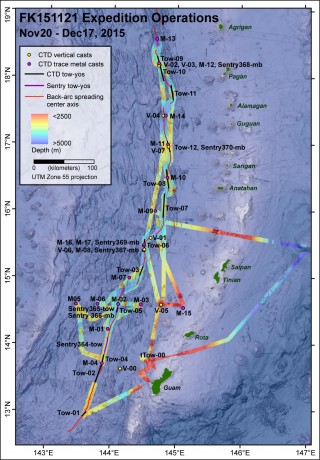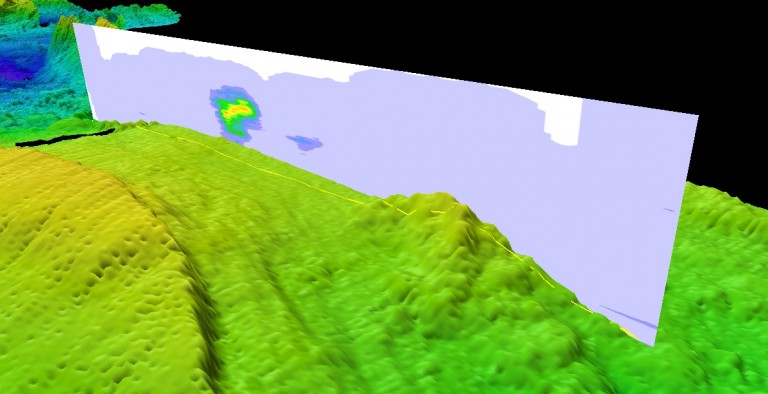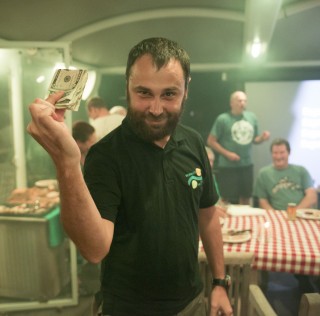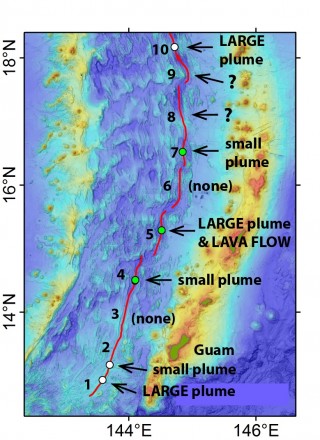
During the Hydrothermal Hunt, we have been searching for new hydrothermal vents in a vast unexplored stretch of the Mariana Back-arc, a zone where we know submarine volcanism occurs (at least occasionally), providing the heat for seafloor hot springs and their weird-and-wonderful chemosynthetic ecosystems. A few days ago, we had only 2 segments still to go (segments 8 & 9) of the 10 back-arc segments we set out to survey, and the results of our betting pool hinged on the results. The end of the cruise was coming up fast and we knew we only had time for two more tow-yos and one more AUV Sentry dive.
You Never Know Until You Look
We first surveyed Segment 9 with a CTD tow-yo because it has a long axial ridge with volcanic morphology and appeared to be a better candidate to have hydrothermal venting. But alas, no plume signals were found there. That left only Segment 8, which seemed even more of a long shot, because its morphology is enigmatic. The bathymetry at the shallowest part of the segment appears unusually smooth – neither obviously volcanic nor tectonic – and we’ve been debating among ourselves all cruise about what that might mean. Is that because it is heavily sedimented and long-dormant – therefore unlikely to have active vents? Or has it been repaved by young fluid sheet flows of lava over a very large area (which would be encouraging, but very unusual for a slow-spreading ridge)? Facts were unclear. I, personally, was a doubter, and had already written Segment 8 off in my head – in fact, I was already planning our last Sentry dive for another site. But I was wrong, and this demonstrates why exploration is so exciting: we don’t really know what we are going to find until we actually look! Segment 8 had another surprise in store of us (or at least for me). The CTD tow-yo showed a large hydrothermal plume right at the shallowest part of Segment 8, so we quickly planned our final AUV Sentry dive there to localize the vents on the seafloor and to do a photo survey.

And the Winner is…

But how does the Segment 8 plume compare to the others we’ve found during this expedition? It was a big one, with strong signals from both chemical and optical sensors (suggesting an high-temperature vent field), but it was not big enough to de-throne our previous leader. Now that we have surveyed all the 10 back-arc segments, we can now announce that the winner of the “biggest plume competition” is… Segment 10! Our winner on board is Falkor crewmember, Todor Gerasimov, the Electro Technical Officer.
Shore-side, we’re happy to announce that Rafi Latif from London, United Kingdom is the winner of the online competition. He was randomly selected from the pool of correct responses.
Cruise Summary

The discovery of a hydrothermal plume at Segment 8 adds to our total for the cruise. Overall, we have discovered four new hydrothermal vent sites, and at one of them we found that at least some of the venting was coming from a recently erupted lava flow! That lava flow is the deepest historical eruption yet discovered (at 4100-4450 m), and the first to be documented on a slow-spreading ridge. In addition, we were able to map the previously known Alice Springs hydrothermal site (on Map 10) in unprecedented detail with AUV Sentry. We are grateful to the captain and crew of R/V Falkor and the AUV Sentry team for all the fantastic support they have given us during this expedition. They have all been extraordinarily friendly, accommodating, and engaged in helping us accomplish our goals on this research cruise. We also greatly appreciate the NOAA Ocean Exploration and Research Program and NOAA’s Pacific Island Regional Office who supported the science on this expedition.
Our results from this cruise give us a set of great targets for next year, when we will return with R/V Falkor and a remotely operated vehicle to make dives at these new hydrothermal sites. We will then be able to see what they look like on the seafloor, take samples of the vent fluids for chemical analysis, and determine what animals and microbes are living at these new back-arc vents. This will allow us answer our “big picture” questions: are all the back-arc vents similar to each other geologically, chemically, and biologically? Do the same suite of chemosynthetic animals live at all the back-arc vents? How connected are the back-arc vents to one another? And how different are they from the better-known hydrothermal vents in the shallow volcanic arc? In the end we will have a better understanding of the global biogeography of vent organisms and their dependence on geologic and chemical environment.

